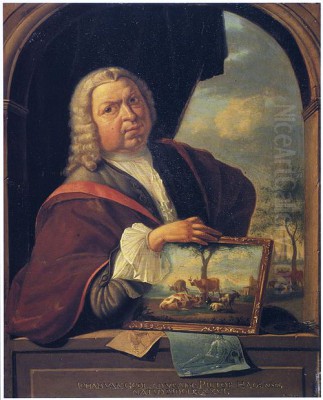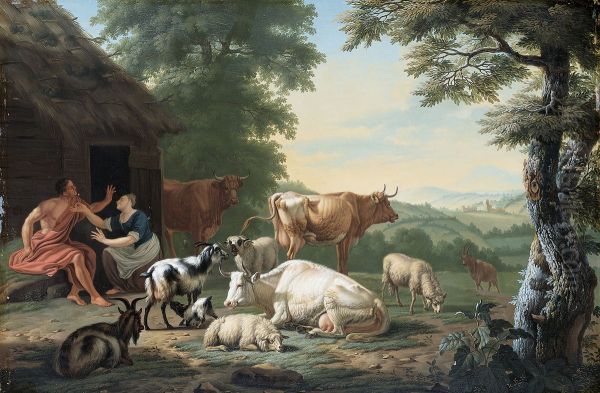
Jan van Gool stands as a significant figure in the landscape of Dutch art history, bridging the gap between the celebrated Golden Age of the 17th century and the evolving artistic scene of the 18th century. Born in The Hague in 1685 and passing away there in 1763, Van Gool navigated a dual career as both a practicing painter and, more enduringly, as a biographer and critic of Netherlandish artists. His contributions offer invaluable insights into a period often overshadowed by its predecessor, revealing the continuities, changes, and challenges faced by artists in his time.
Early Life and Artistic Formation
Jan van Gool's artistic journey began in The Hague, a city with a rich cultural heritage and a prominent center for the arts, distinct from the commercial hub of Amsterdam or the historic university town of Leiden. His formal training placed him under the tutelage of Arnold Houbraken, a painter but more famously the author of De Groote Schouburgh der Nederlantsche Konstschilders en Schilderessen (The Great Theatre of Netherlandish Painters and Paintresses, 1718-1721). This connection was pivotal, not only for Van Gool's artistic development but also for inspiring his own later biographical project. Houbraken's work provided a model, chronicling the lives of artists primarily from the 15th to the late 17th centuries. Van Gool would eventually see the need to continue this narrative into his own era.
The Painter: Style and Subjects
As a painter, Jan van Gool specialized in themes that were popular in the late 17th and early 18th centuries, particularly Italianate landscapes. These were not necessarily depictions of specific Italian locations visited by the artist, but rather idealized pastoral scenes evoking the light, atmosphere, and rustic charm associated with the Roman Campagna and its surroundings. His canvases often feature shepherds, shepherdesses, and their flocks resting amidst gentle hills, sometimes near classical ruins or quaint farm buildings. This genre had been popularized by earlier Dutch Italianate painters and continued to find favour among patrons seeking tranquil and picturesque imagery.

Van Gool's style is characterized by careful execution, a soft palette, and attention to detail, especially in the rendering of animals – cattle, sheep, and goats are frequent protagonists in his compositions. He worked primarily in oil paint but was also known to produce prints. His approach emphasized harmonious composition and a certain sentimental quality, focusing on the peaceful coexistence of humans, animals, and nature. While perhaps not possessing the innovative power of the great 17th-century masters, his work was competent, pleasing, and catered effectively to the tastes of his time.
Representative Works and Patronage
Pinpointing specific, universally recognized masterpieces by Jan van Gool the painter can be challenging, as his fame rests more heavily on his writings. However, his oeuvre consists of numerous examples of the pastoral and animal genres he favoured. Titles often reflect their descriptive nature, such as "Landscape with Shepherds and Cattle," "Italianate Landscape with Resting Animals," or "Pastoral Scene." These works found their way into collections and were sometimes used for decorative purposes in the estates of the affluent. Sources mention his paintings gracing locations like the residences of the Duke of Orléans in France and the Earl of Cholmondeley in England, indicating a degree of international recognition and appeal among aristocratic patrons.
His paintings demonstrate a clear lineage from artists like Adriaan van de Velde, known for similar pastoral subjects and delicate animal painting. Van Gool absorbed these influences, adapting them into his own refined, sometimes slightly more decorative, 18th-century idiom. The recurring motif of resting figures and animals imbues his work with a sense of calm and idyllic simplicity, offering an escape from the complexities of urban life.
The Art of Imitation
An interesting aspect of Van Gool's practice, and one he noted in others like his pupil Adriaan van der Burg, was a talent for imitation. He was reportedly skilled at painting "in the manner of" established masters, particularly those renowned for landscapes and animals, such as Philips Wouwerman, famous for his horse scenes and battle pieces, and the aforementioned Adriaan van de Velde. This ability was not uncommon at the time; creating works alla maniera di a famous artist could be a demonstration of technical virtuosity or a way to meet market demand for works resembling those of highly sought-after names.
Van Gool himself mentioned that such imitations could be so convincing that even experts found them difficult to distinguish from originals. While this raises modern questions about authenticity, in the 18th century, the practice occupied a more ambiguous space, sometimes viewed as homage or skillful adaptation rather than outright forgery, though the potential for deception certainly existed, a point Van Gool himself would address in his writings on the art market. His own skill in this area likely gave him particular insight into the techniques and styles of his predecessors.
The Writer: De Nieuwe Schouburg
Jan van Gool's most lasting contribution is undoubtedly his biographical work, De Nieuwe Schouburg der Nederlantsche kunstschilders en schilderessen (The New Theatre of Netherlandish Painters and Paintresses). Published in two volumes (1750-1751), this ambitious project was conceived as a direct continuation of Arnold Houbraken's De Groote Schouburgh. Houbraken's account had largely concluded with artists active around the turn of the 18th century; Van Gool aimed to document the subsequent generations, covering artists born roughly after 1670 or who flourished in the first half of the 18th century.
De Nieuwe Schouburg is an indispensable primary source for information on numerous Dutch and Flemish artists of this period. It contains biographies of varying lengths, anecdotes, descriptions of works, and insights into the artistic networks and institutions of the time, such as the painters' guilds and drawing academies. Van Gool drew on personal acquaintance, studio visits, information from colleagues, and existing records to compile his accounts. Like Houbraken's work, it is written in an engaging, often anecdotal style, making it accessible beyond a purely scholarly audience.
Van Gool as Biographer: Documenting Contemporaries
Within the pages of De Nieuwe Schouburg, Van Gool provides valuable details about many artists whose names might otherwise be obscure today. He wrote, for instance, about his own pupil, Adriaan van der Burg, noting his talent for imitation. He penned a biography of the celebrated flower painter Rachel Ruysch, even including a poem dedicated to her, highlighting her long and successful career that extended well into the 18th century. He also documented her contemporary and rival in flower painting, Jan van Huysum, whose meticulous technique was highly admired.
His scope included genre painters like Jacob Ochtervelt, whom Van Gool perceptively compared to Gabriel Metsu, suggesting an artistic lineage or similarity in style. He discussed figures active in The Hague's art scene, including Nicolaes Willingh (or Willeming), who, despite being German-born, was active in the city. The book touches upon landscape painters, portraitists, and specialists in various genres, reflecting the diversity of artistic production in the period. Through these biographies, Van Gool preserved crucial information about training, patronage, artistic collaborations, and personal circumstances.
Art Criticism and Market Commentary
Beyond mere biography, De Nieuwe Schouburg also served as a platform for Jan van Gool's own views on art and the contemporary art world. He often adopted a critical, somewhat conservative stance, frequently lamenting what he perceived as a decline in artistic quality compared to the masters of the 17th century. He was particularly concerned about the impact of commercialism on art.
Van Gool voiced strong opinions about the negative influence of art dealers, whom he accused of manipulating the market, commissioning copies, and passing off inferior works as originals to unsuspecting collectors. He believed these practices not only defrauded buyers but also discouraged genuine talent and lowered overall artistic standards. His criticism extended to figures like the painter and dealer Gerard Hoet, whose defence of certain market practices Van Gool contested. He published pamphlets separately (in 1751 and 1753) discussing the issues of copies and the commercialization of Dutch painting, advocating for greater integrity and appreciation of true skill.
His writings reveal a deep concern for the status and livelihood of artists and the preservation of artistic quality. He championed diligence, originality (within the bounds of tradition), and adherence to the high standards set by the Golden Age. His commentary provides a fascinating window into the economic realities and ethical debates within the 18th-century Dutch art market.
Connections and Contemporaries
Jan van Gool was well-integrated into the art world of his time, particularly in The Hague. His relationship with Arnold Houbraken was foundational. His role as a teacher connected him to the next generation through pupils like Adriaan van der Burg. His writings brought him into contact, either personally or through research, with a wide array of artists.
His book mentions numerous figures, reflecting his awareness of the broader artistic landscape. He references esteemed 17th-century landscape painters like Meindert Hobbema, whom he termed a "modern landscape painter," and compared him to Salomon van Ruysdael. He also acknowledged the contributions of earlier Haarlem landscape pioneers like Pieter Molijn and Esaias van de Velde. His discussions implicitly and explicitly connect the artists of his own time to this rich heritage, evaluating them against established benchmarks. His membership and activity within The Hague's Confrerie Pictura, the local guild of artists, would have further embedded him within this professional network.
Later Life and Enduring Legacy
Jan van Gool remained active as both a painter and writer into his later years. He completed his Nieuwe Schouburg when he was in his mid-sixties, a testament to his dedication to the project. He continued to paint, producing the calm, pastoral scenes that were his specialty. He passed away in The Hague in 1763, leaving behind a dual legacy.
As a painter, Jan van Gool represents a competent and appealing exponent of the later Dutch Italianate landscape tradition. His works are charming examples of 18th-century taste, valued for their peaceful atmosphere and delicate execution. However, his more significant and enduring impact lies in his role as an art historian and biographer.
De Nieuwe Schouburg remains a cornerstone for the study of early 18th-century Netherlandish art. While modern scholarship approaches it critically, aware of its potential biases, inaccuracies, and anecdotal nature (common traits in early art historiography), its value is undeniable. It preserved the memory and careers of countless artists, offered contemporary perspectives on art and the market, and provided a crucial link in the chain of Dutch art historical writing initiated by Karel van Mander and continued by Houbraken. Van Gool ensured that the "Silver Age" of Dutch art, though perhaps less brilliant than the Golden Age, would not be forgotten.
Conclusion: Painter and Chronicler
Jan van Gool occupies a unique position in Dutch art history. He was an active participant in the artistic life of the 18th century as a painter of refined Italianate landscapes and animal scenes. Simultaneously, he was a dedicated observer and chronicler of that same world. His paintings offer a glimpse into the prevailing tastes of his era, while his writings, particularly De Nieuwe Schouburg, provide an invaluable, if subjective, record of the artists who shaped it. His work serves as a vital bridge, connecting us to the personalities, practices, and preoccupations of the Dutch art world more than two centuries after his death. He remains essential reading for anyone seeking to understand the continuation and transformation of the Netherlandish artistic tradition beyond its 17th-century zenith.